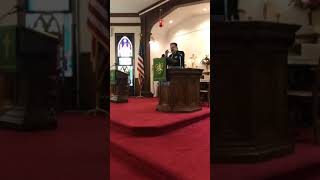Is Religion an Exercise in Futility?
I would like to thank Mr. Hudson for his article, “Religion an exercise in futility,” which appeared in the January 25th, 2021 edition of the Standard Speaker. It has given me an opportunity to expand on his thoughts presented as evidence, and ponder thoughts that have been debated many, many times before.
The story of the crucifixion of Christ can be found in Matthew 27:15-26; Mark 15:6-15; Luke 23:26-43 and John 18:39-19:16. The Book of Luke states Jesus was crucified at “the place called the Skull” (vs. 33). The word Golgotha, as Christians refer to the site if the crucifixion in the Aramaic language means, “place of the Skull.” The Latin word for Skull is calvaria which in English is referred to as Calvary. The location of the place which carries these names is located outside the walls of Jericho. Biblical narrative indicates that Christ’s crucifixion happened outside of the city walls. It is, in present times, difficult to pin-point the exact location of the crucifixion as the walls around Jerusalem have changed greatly over the years.
Archeologists have placed the site of Calvary at the location which is now the Church of the Holy Sepulcher. This location would put the site just outside the city walls as they existed during the time period. This site would also align itself perfectly with the destination of what archeologists have pinpointed as the Via Dolorosa, the path Jesus walked with His cross from Pontius Pilate’s courtyard to Golgotha.
The shrine that holds the tomb of Jesus Christ is also located in the Church of the Holy Sepulcher. Scientific tests show this tomb dates to almost 1,700 years. Therefore, the site of the crucifixion and resurrection of Jesus from this tomb have been located through archeological exploration. Pleas realize the events in Christ’s life at the time they occurred for future reference would have been extremely dangerous for Jesus’ followers, which were being threatened with death also.
Regarding those writers of the Bible, I would like to focus on just Mark at the present. The Book of Mark was written by John Mark, the son of a Jerusalem widow. His home was a meeting place for the early Christians (Acts 12:12). Jesus’ death, resurrection, and ascension occurred A.D.30. Mark wrote his book as early as 50 A.D. The reason for this delay could have been again fear of being labeled a follower of Jesus and put to death, thus unable to carry on the ministry of Christ found in the Book of Acts.
Finally, the date of Christmas. Not being well versed in Saturnalia, I am versed in an excellent writing titled, “The Golden Bough,” written by Sir James George Frazer (1854-1941), a highly influential 19th century comparative study of religion and mythology. Frazer approached the topic of religion from a cultural — not theological — perspective. He states that the Gospels say nothing as to the day of Christ’s birth, and accordingly the early Church did not celebrate it. In time, however, the Christians of Egypt came to regard the sixth of January as the date of the Nativity, and the custom of commemorating the birth of the Saviour on that day gradually spread until by the fourth century it was universally established in the East. But at the end of the third or the beginning of the fourth century the Western Church, which had never recognised the sixth of January as the day of the Nativity, adopted the twenty-fifth of December as the true date, and in time its decision was accepted also by the Eastern Church. At Antioch the change was not introduced till about the year 375 A.D.
The earliest mention of December 25 as Jesus’ birthday comes from a mid-fourth-century Roman almanac that lists the death dates of various Christian bishops and martyrs. The first date listed, December 25, is marked: natus Christus in Betleem Judeae: “Christ was born in Bethlehem of Judea … ” So, almost 300 years after Jesus was born, we finally find people observing his birth in mid-winter.” Bottom line: Nobody knows for sure why Dec. 25 is celebrated as Christmas.
In closing, my religious experience is based on faith. Hebrews 11:1 writes, “Now faith is the assurance of things hoped for, the conviction of things not seen.” My hope is that everyone exercises their right to question, and that question leads to further study. In that study you will find the ultimate answer which is the unquestionable love God has for His creation regardless of dates and ancient pagan stories.

